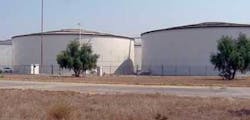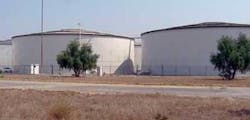Real-Time Control Helps System Meet Treatment Objectives
It can be challenging to deliver uninterrupted drinking water to the fifth largest city in the state of California. Yet the Long Beach Water Department (LBWD) successfully completes this mission 24 hours a day, seven days a week, while consistently meeting or surpassing federal and state drinking water regulations. LBWD also operates and maintains nearly 765 miles of sewer lines, delivering more than 40 million gallons of wastewater per day to Los Angeles County sanitation district facilities on the north and south sides of Long Beach.
The Long Beach Water Department uses sophisticated technology solutions to help it maintain communications over the entire system in real time.
To enable control room staff to monitor and manage more than 90 remote telemetry units (RTUs) and its groundwater treatment facility, the water department selected a comprehensive SCADA software solution from Wonderware, a business unit of Invensys Systems Inc. Wonderware’s SuiteVoyager, ActiveFactory and IndustrialSQL Server (InSQL) software are used for engineering and development applications throughout the municipal water district.
“Installing Wonderware’s open system has enabled LBWD to not only improve efficiencies but continually lay the groundwork for future increases in the effectiveness of the city’s groundwater and sewage treatment systems,” said Ray Gonzales, the Long Beach Water Department’s telecommunications manager. “Supporting a large city such as Long Beach requires the accurate monitoring and control of all our facilities, and Wonderware’s solutions provided the right tools to help us accomplish this.”
The SCADA configuration for the district’s water system gathers information from nearly 30,000 data points via RTU sites and programmable logic controllers (PLCs) at 85 major equipment sites. The system is PC-based and uses the Microsoft® Windows® XP operating system with Wonderware’s InTouch human-machine interface (HMI) software, which provides real-time visualization capabilities to monitor and control different sites.
The department programmed its PLC processor to poll the water system’s remote sites an average of once every minute to ensure efficient operations. The data is stored in Wonderware’s IndustrialSQL Server historian. The historian combines the power and flexibility of a relational database with the speed and compression of a real-time system, enabling the water department’s main office to have simultaneous access to multiple data inputs from pumps, valves and equipment throughout the city.
The historian provides operators with a complete picture of the city’s water system processes at any given time, thereby improving overall performance. With this level of visibility, subtle water treatment process inefficiencies and any water-quality problems can be identified and corrected.
Additional data critical to operations, such as where a leak on a pipeline has occurred, can be transferred back to the central site in real time. By alerting the primary station that the leak has occurred, operators can perform analysis and control activities. For instance, they can determine if the leak is critical and then share a description of the leak in a logical and organized fashion using the SuiteVoyager portal software.
The system is designed to allow remote control of equipment. Operators can increase response time by remotely turning pumps on or off or adjusting valves without having to send staff to the specific location to fix the problem.
The ability to remotely control equipment also allows the water department to adjust water pressure in emergency situations. This may include pumping water to an area where there’s a fire or increasing water pressure to hillsides for improved water availability.
Collecting information from RTUs in real time enables the department to more easily monitor field equipment and perform critical system maintenance. The data can be analyzed to predict system problems. For example, staff can proactively replace potentially defective pumps or valves before they actually create trouble.
The control-room operators and engineers in the water district’s treatment plant also use Wonderware’s ActiveFactory trending and analysis software to generate daily reports. The ActiveFactory software maximizes the value of the data stored in the water department’s IndustrialSQL Server historian. Users can generate reports directly from the operator’s InTouch HMI screen or feed data into a program such as Microsoft Excel to analyze trends in the chemical and groundwater treatment processes.
“Trending and analysis are critical components of our water operations program because they help us make informed decisions to ensure proper water quality levels,” Gonzales said. “The ability to troubleshoot potential problems and view real-time and historical process data makes the IndustrialSQL Server and ActiveFactory software invaluable tools for LBWD’s overall operations.”
ActiveFactory software can disseminate information across a network, corporate intranet or the Internet. By supplying real-time plant information to anyone in the enterprise who needs it, ActiveFactory clients, in conjunction with other Wonderware SCADA software tools, can help improve plant operations and performance.
LBWD also uses the Microsoft Windows XP operating system and Wonderware InTouch HMI software for its groundwater treatment facility. As the largest groundwater treatment plant in the U.S., the department’s facility is considered one of the most modern plants in the world. The Long Beach Water Department’s distributed control system links nearly 1,500 data points from eight separate RTUs.
To manage and control its sanitary sewer and storm drains, the water department uses Wonderware’s InTouch HMI to support its operator interfaces. The control system consists of two PCs and one data collection server that poll the department’s 50 remote sites an average of once every minute. Through continuous monitoring of the city’s sewer and storm drains, department operators can determine if pumping stations need to reroute water along different mains.
As part of this project, embedded system alarms also were configured to warn operators about potential sewer overfills. Deriving information from its remote telemetry units, water department operators can identify and locate sewer mainlines and assess lateral repair needs without undertaking what could be very expensive street excavation.
According to Gonzales, the department considers its current Wonderware implementation a great success.
“Now that real-time data is accessible from all of the remote sites and our treatment plant, we no longer have to employ additional operators and maintenance staff to control various equipment and pumping stations throughout the city,” he said. “Considering this advantage - along with the open nature of the solutions, and the fact that the systems can be maintained in-house - we estimate an average annual return of $300,000 on the current investment.”



